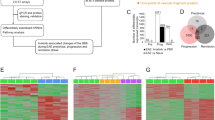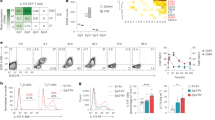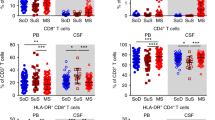Abstract
Inflammation in the central nervous system (CNS) and disruption of its immune privilege are major contributors to the pathogenesis of multiple sclerosis (MS) and of its rodent counterpart, experimental autoimmune encephalomyelitis (EAE). We have previously identified developmental endothelial locus-1 (Del-1) as an endogenous anti-inflammatory factor, which inhibits integrin-dependent leukocyte adhesion. Here we show that Del-1 contributes to the immune privilege status of the CNS. Intriguingly, Del-1 expression decreased in chronic-active MS lesions and in the inflamed CNS in the course of EAE. Del-1-deficiency was associated with increased EAE severity, accompanied by increased demyelination and axonal loss. As compared with control mice, Del-1−/− mice displayed enhanced disruption of the blood–brain barrier and increased infiltration of neutrophil granulocytes in the spinal cord in the course of EAE, accompanied by elevated levels of inflammatory cytokines, including interleukin-17 (IL-17). The augmented levels of IL-17 in Del-1-deficiency derived predominantly from infiltrated CD8+ T cells. Increased EAE severity and neutrophil infiltration because of Del-1-deficiency was reversed in mice lacking both Del-1 and IL-17 receptor, indicating a crucial role for the IL-17/neutrophil inflammatory axis in EAE pathogenesis in Del-1−/− mice. Strikingly, systemic administration of Del-1-Fc ameliorated clinical relapse in relapsing–remitting EAE. Therefore, Del-1 is an endogenous homeostatic factor in the CNS protecting from neuroinflammation and demyelination. Our findings provide mechanistic underpinnings for the previous implication of Del-1 as a candidate MS susceptibility gene and suggest that Del-1-centered therapeutic approaches may be beneficial in neuroinflammatory and demyelinating disorders.
This is a preview of subscription content, access via your institution
Access options
Subscribe to this journal
Receive 12 print issues and online access
$259.00 per year
only $21.58 per issue
Buy this article
- Purchase on Springer Link
- Instant access to full article PDF
Prices may be subject to local taxes which are calculated during checkout





Similar content being viewed by others
References
Rebenko-Moll NM, Liu L, Cardona A, Ransohoff RM . Chemokines mononuclear cells and the nervous system: heaven (or hell) is in the details. Curr Opin Immunol 2006; 18: 683–689.
Korn T . Pathophysiology of multiple sclerosis. J Neurol 2008; 255 (Suppl 6): 2–6.
Ransohoff RM . Natalizumab for multiple sclerosis. N Engl J Med 2007; 356: 2622–2629.
Xie C, Alcaide P, Geisbrecht BV, Schneider D, Herrmann M, Preissner KT, et al. Suppression of experimental autoimmune encephalomyelitis by extracellular adherence protein of Staphylococcus aureus. J Exp Med 2006; 203: 985–994.
Rothhammer V, Heink S, Petermann F, Srivastava R, Claussen MC, Hemmer B, et al. Th17 lymphocytes traffic to the central nervous system independently of alpha4 integrin expression during EAE. J Exp Med 2011; 208: 2465–2476.
Rudick R, Polman C, Clifford D, Miller D, Steinman L . Natalizumab: bench to bedside and beyond. JAMA Neurol 2013; 70: 172–182.
Steinman L . A molecular trio in relapse and remission in multiple sclerosis. Nat Rev Immunol 2009; 9: 440–447.
Bullard DC, Hu X, Schoeb TR, Collins RG, Beaudet AL, Barnum SR . Intercellular adhesion molecule-1 expression is required on multiple cell types for the development of experimental autoimmune encephalomyelitis. J Immunol 2007; 178: 851–857.
Dugger KJ, Zinn KR, Weaver C, Bullard DC, Barnum SR . Effector and suppressor roles for LFA-1 during the development of experimental autoimmune encephalomyelitis. J Neuroimmunol 2009; 206: 22–27.
Chavakis E, Choi EY, Chavakis T . Novel aspects in the regulation of the leukocyte adhesion cascade. Thromb Haemost 2009; 102: 191–197.
Hajishengallis G, Chavakis T . Endogenous modulators of inflammatory cell recruitment. Trends Immunol 2013; 34: 1–6.
Choi EY, Chavakis E, Czabanka MA, Langer HF, Fraemohs L, Economopoulou M, et al. Del-1, an endogenous leukocyte–endothelial adhesion inhibitor, limits inflammatory cell recruitment. Science 2008; 322: 1101–1104.
Chavakis T . Leucocyte recruitment in inflammation and novel endogenous negative regulators thereof. Eur J Clin Invest 2012; 42: 686–691.
Mitroulis I, Kang YY, Gahmberg CG, Siegert G, Hajishengallis G, Chavakis T, et al. Developmental endothelial locus-1 attenuates complement-dependent phagocytosis through inhibition of Mac-1-integrin. Thromb Haemost 2014; 111: 1004–1006.
Eskan MA, Jotwani R, Abe T, Chmelar J, Lim JH, Liang S, et al. The leukocyte integrin antagonist Del-1 inhibits IL-17-mediated inflammatory bone loss. Nat Immunol 2012; 13: 465–473.
Goris A, Sawcer S, Vandenbroeck K, Carton H, Billiau A, Setakis E, et al. New candidate loci for multiple sclerosis susceptibility revealed by a whole genome association screen in a Belgian population. J Neuroimmunol 2003; 143: 65–69.
Shin J, Hosur KB, Pyaram K, Jotwani R, Liang S, Chavakis T, et al. Expression and function of the homeostatic molecule Del-1 in endothelial cells and the periodontal tissue. Clin Dev Immunol 2013; 2013: 617–809.
Langer HF, Choi EY, Zhou H, Schleicher R, Chung KJ, Tang Z, et al. Platelets contribute to the pathogenesis of experimental autoimmune encephalomyelitis. Circ Res 2012; 110: 1202–1210.
Dasgupta SK, Le A, Chavakis T, Rumbaut RE, Thiagarajan P . Developmental endothelial locus-1 (Del-1) mediates clearance of platelet microparticles by the endothelium. Circulation 2012; 125: 1664–1672.
Kanczkowski W, Chatzigeorgiou A, Grossklaus S, Sprott D, Bornstein SR, Chavakis T . Role of the endothelial-derived endogenous anti-inflammatory factor Del-1 in inflammation-mediated adrenal gland dysfunction. Endocrinology 2013; 154: 1181–1189.
Glass CK, Saijo K, Winner B, Marchetto MC, Gage FH . Mechanisms underlying inflammation in neurodegeneration. Cell 2010; 140: 918–934.
Ajami B, Bennett JL, Krieger C, McNagny KM, Rossi FM . Infiltrating monocytes trigger EAE progression, but do not contribute to the resident microglia pool. Nat Neurosci 2011; 14: 1142–1149.
McCandless EE, Budde M, Lees JR, Dorsey D, Lyng E, Klein RS . IL-1R signaling within the central nervous system regulates CXCL12 expression at the blood–brain barrier and disease severity during experimental autoimmune encephalomyelitis. J Immunol 2009; 183: 613–620.
Chang RA, Miller SD, Longnecker R . Epstein–Barr virus latent membrane protein 2A exacerbates experimental autoimmune encephalomyelitis and enhances antigen presentation function. Sci Rep 2012; 2: 353.
Ford AL, Goodsall AL, Hickey WF, Sedgwick JD . Normal adult ramified microglia separated from other central nervous system macrophages by flow cytometric sorting. Phenotypic differences defined and direct ex vivo antigen presentation to myelin basic protein-reactive CD4+ T cells compared. J Immunol 1995; 154: 4309–4321.
Becher B, Durell BG, Noelle RJ . IL-23 produced by CNS-resident cells controls T cell encephalitogenicity during the effector phase of experimental autoimmune encephalomyelitis. J Clin Invest 2003; 112: 1186–1191.
Lin AM, Rubin CJ, Khandpur R, Wang JY, Riblett M, Yalavarthi S, et al. Mast cells and neutrophils release IL-17 through extracellular trap formation in psoriasis. J Immunol 187: 490–500.
Carlson T, Kroenke M, Rao P, Lane TE, Segal B . The Th17-ELR+ CXC chemokine pathway is essential for the development of central nervous system autoimmune disease. J Exp Med 2008; 205: 811–823.
Komiyama Y, Nakae S, Matsuki T, Nambu A, Ishigame H, Kakuta S, et al. IL-17 plays an important role in the development of experimental autoimmune encephalomyelitis. J Immunol 2006; 177: 566–573.
Hirota K, Duarte JH, Veldhoen M, Hornsby E, Li Y, Cua DJ, et al. Fate mapping of IL-17-producing T cells in inflammatory responses. Nat Immunol 2011; 12: 255–263.
Huber M, Heink S, Pagenstecher A, Reinhard K, Ritter J, Visekruna A, et al. IL-17A secretion by CD8+ T cells supports Th17-mediated autoimmune encephalomyelitis. J Clin Invest 2013; 123: 247–260.
t Hart BA, Gran B, Weissert R . EAE: imperfect but useful models of multiple sclerosis. Trends Mol Med 2011; 17: 119–125.
Cua DJ, Tato CM . Innate IL-17-producing cells: the sentinels of the immune system. Nat Rev Immunol 2010; 10: 479–489.
Kebir H, Kreymborg K, Ifergan I, Dodelet-Devillers A, Cayrol R, Bernard M, et al. Human TH17 lymphocytes promote blood–brain barrier disruption and central nervous system inflammation. Nat Med 2007; 13: 1173–1175.
Berard JL, Wolak K, Fournier S, David S . Characterization of relapsing-remitting and chronic forms of experimental autoimmune encephalomyelitis in C57BL/6 mice. Glia 2010; 58: 434–445.
Kroenke MA, Carlson TJ, Andjelkovic AV, Segal BM . IL-12- and IL-23-modulated T cells induce distinct types of EAE based on histology, CNS chemokine profile, and response to cytokine inhibition. J Exp Med 2008; 205: 1535–1541.
Stromnes IM, Cerretti LM, Liggitt D, Harris RA, Goverman JM . Differential regulation of central nervous system autoimmunity by T(H)1 and T(H)17 cells. Nat Med 2008; 14: 337–342.
Domingues HS, Mues M, Lassmann H, Wekerle H, Krishnamoorthy G . Functional and pathogenic differences of Th1 and Th17 cells in experimental autoimmune encephalomyelitis. PLoS One 2010; 5: e15531.
Berghmans N, Nuyts A, Uyttenhove C, Van Snick J, Opdenakker G, Heremans H . Interferon-gamma orchestrates the number and function of Th17 cells in experimental autoimmune encephalomyelitis. J Interferon Cytokine Res 2011; 31: 575–587.
Xiao BG, Ma CG, Xu LY, Link H, Lu CZ . IL-12/IFN-gamma/NO axis plays critical role in development of Th1-mediated experimental autoimmune encephalomyelitis. Mol Immunol 2008; 45: 1191–1196.
Ferber IA, Brocke S, Taylor-Edwards C, Ridgway W, Dinisco C, Steinman L, et al. Mice with a disrupted IFN-gamma gene are susceptible to the induction of experimental autoimmune encephalomyelitis (EAE). J Immunol 1996; 156: 5–7.
Huppert J, Closhen D, Croxford A, White R, Kulig P, Pietrowski E, et al. Cellular mechanisms of IL-17-induced blood–brain barrier disruption. FASEB J 24: 1023–1034.
Bettelli E, Oukka M, Kuchroo VK . T(H)-17 cells in the circle of immunity and autoimmunity. Nat Immunol 2007; 8: 345–350.
Haak S, Croxford AL, Kreymborg K, Heppner FL, Pouly S, Becher B, et al. IL-17A and IL-17F do not contribute vitally to autoimmune neuro-inflammation in mice. J Clin Invest 2009; 119: 61–69.
Steinman L . A rush to judgment on Th17. J Exp Med 2008; 205: 1517–1522.
Hu Y, Ota N, Peng I, Refino CJ, Danilenko DM, Caplazi P, et al. IL-17RC is required for IL-17A- and IL-17F-dependent signaling and the pathogenesis of experimental autoimmune encephalomyelitis. J Immunol 184: 4307–4316.
Gonzalez-Garcia I, Zhao Y, Ju S, Gu Q, Liu L, Kolls JK, et al. IL-17 signaling-independent central nervous system autoimmunity is negatively regulated by TGF-beta. J Immunol 2009; 182: 2665–2671.
Das Sarma J, Ciric B, Marek R, Sadhukhan S, Caruso ML, Shafagh J, et al. Functional interleukin-17 receptor A is expressed in central nervous system glia and upregulated in experimental autoimmune encephalomyelitis. J Neuroinflamm 2009; 6: 14.
Tzartos JS, Friese MA, Craner MJ, Palace J, Newcombe J, Esiri MM, et al. Interleukin-17 production in central nervous system-infiltrating T cells and glial cells is associated with active disease in multiple sclerosis. Am J Pathol 2008; 172: 146–155.
Ramanan VK, Risacher SL, Nho K, Kim S, Swaminathan S, Shen L, et al. APOE and BCHE as modulators of cerebral amyloid deposition: a florbetapir PET genome-wide association study. Mol Psychiatry 2013; 19: 351–357.
Acknowledgements
This work was supported by grants from the National Research Foundation of Korea (NRF) funded by the Ministry of Education, Science and Technology of Korea (2011-0014447 and 2008-0062286 to EYC), from the Novartis Foundation for Therapeutical Research (to TC and EYC), from the US NIH Extramural Program (DE021685 and DE017138 to GH), the NIH Intramural Research Program, National Cancer Institute (to TC), the Deutsche Forschungsgemeinschaft (CH279/5-1 to TC), by a European Commission International Reintegration Grant (2010-268108, ANTIINFLDEL to TC) and the European Research Council (ENDHOMRET to TC). EC was supported by the Else Kröner-Fresenius-Stiftung, the Excellence Cluster Cardiopulmonary System (DFG; Exc147-1), the German Centre for Cardiovascular Research (BMBF) and the LOEWE Center for Gene and Cell Therapy (Hessen, Germany). We thank S Grossklaus and M Schuster for technical assistance, T Quertermous and R Kundu (Department of Medicine, Stanford University, Stanford, CA, USA) for providing Del-1−/− mice, Amgen for the IL-17RA−/− mice, the imaging core facility of the MTZ-Technische Universität Dresden for help with imaging and Yongqing Zhang, Elin Lehrmann and Kevin G Becker (National Institute of Aging, NIH, Baltimore, MD, USA) for assistance with gene expression analysis.
Author Contributions
EYC designed and performed experiments, analyzed data and wrote the manuscript; JHL designed and performed experiments, analyzed data and wrote the manuscript; AN, ME, SHL, SB, HL, MS, HK and GSC performed experiments; AC, KJC, TZ, KB, EC, JYK, SRB and SGM analyzed data; LB and KH provided important reagents; GH analyzed data and coedited the manuscript; and TC conceived the project, designed some experiments and wrote the manuscript.
Author information
Authors and Affiliations
Corresponding author
Ethics declarations
Competing interests
The authors declare no conflict of interest.
Additional information
Supplementary Information accompanies the paper on the Molecular Psychiatry website
Supplementary information
Rights and permissions
About this article
Cite this article
Choi, E., Lim, JH., Neuwirth, A. et al. Developmental endothelial locus-1 is a homeostatic factor in the central nervous system limiting neuroinflammation and demyelination. Mol Psychiatry 20, 880–888 (2015). https://doi.org/10.1038/mp.2014.146
Received:
Revised:
Accepted:
Published:
Issue Date:
DOI: https://doi.org/10.1038/mp.2014.146
This article is cited by
-
An IL-10/DEL-1 axis supports granulopoiesis and survival from sepsis in early life
Nature Communications (2024)
-
Amelioration of experimental autoimmune encephalomyelitis by in vivo reprogramming of macrophages using pro-resolving factors
Journal of Neuroinflammation (2023)
-
Correlation of systemic metabolic inflammation with knee osteoarthritis
Hormones (2022)
-
Regulatory role of local tissue signal Del-1 in cancer and inflammation: a review
Cellular & Molecular Biology Letters (2021)
-
Serum developmental endothelial locus-1 is associated with severity of sepsis in animals and humans
Scientific Reports (2019)



